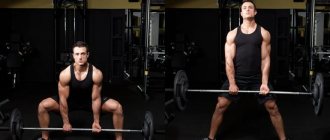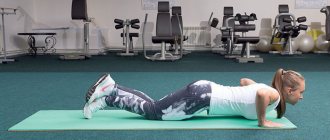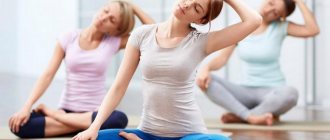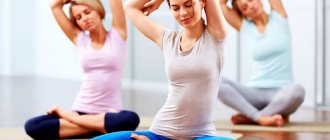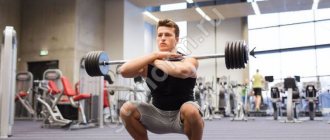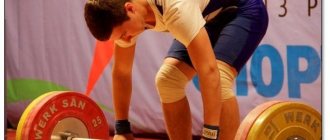Sumo squats are an effective exercise for training the buttocks and adductor surface of the thigh; it will be relevant not only for the fair half of humanity, but also for men, this type of squats is also useful, since with a certain placement of the feet, the load also falls on the quadriceps. The exercise does not involve additional muscles that stabilize the body position, which can be considered an advantage. Squats are performed not only with a barbell, but also with a dumbbell and in a Smith machine. So, what are sumo squats and whether this type of load should be included in the training process, we will find out right now!
Benefits and Disadvantages of Sumo Squats
This exercise is suitable for both men and girls due to its active effect on the muscles of the lower body. When performing sumo squats, those muscles are used that are not used in the classical squat technique. It is also worth noting the following advantages of sumo squats:
- Complex work of the muscles of the legs and buttocks.
- Effective work of the adductor muscles, which is a very relevant activity in women's training.
- Improves hip flexibility and mobility.
- Effectively improves blood circulation in the legs and pelvic organs.
- Ability to work with various weights and sports equipment (barbell, dumbbell, kettlebell, bag and other equipment).
- Sumo squats are suitable for a home exercise routine.
- By reducing the inclination with a dumbbell, the load on the lower back is reduced.
Of course, there are also disadvantages.
- For example, the technique of performing sumo squats is somewhat more complicated than the classic version. In this case, you need to squat widely and carefully ensure that your knees do not bend inward. To do this, you need to use a light weight, at least at first.
- It is also worth noting that sumo squats place a significant load on the knee and hip joints, which, by the way, are in an unusual position throughout the entire range of motion.
Types of squats
- Squats with arm raises Stand straight with your feet shoulder-width apart. Tighten your abs and slowly push your hips back, bending your knees. Make sure the angle between your thigh and shin is 90 degrees. While squatting, straighten your arms above your head so that they are in line with your body.
- Squats with legs abducted to the side Place your legs wider than your shoulders, your feet parallel to each other, and keep your arms in front of you. Do a squat so that your thighs are parallel to the floor. As you exit, move your left leg out to the side and up. Squat down again and repeat the same with your right leg. This counts as one repetition.
- Squats with narrow legs The technique for performing this exercise is the same as in a classic squat. The only nuance is that the feet are brought together and the hands are clasped at chest level. Do a squat, and when you come out, take your leg back, with your hands on your belt.
- Squats with dumbbell press Hold dumbbells in both hands with the weight that is optimal for you. Stand straight with your feet shoulder-width apart and your arms straight above your head. As you inhale, squat down and bend your elbows at shoulder level; as you exhale, return to the starting position, pushing the dumbbells up.
- Front Squats Hold the dumbbells directly above your shoulders. While doing the exercise, try to maintain a straight body position and do not lower your elbows when you squat.
- Deep squats with weight Place your feet slightly wider than your shoulders and hold a dumbbell in your hands. Do a deep squat, keep your body straight, do not lean forward. Watch your breathing.
- Squats + plank Squat down, then jump into a plank and return to the squat in the same way. Next, return to the starting position.
- Jump Squats Squat down, then jump back to the starting position. In this case, the back is straight, legs are extended, arms are stretched up.
- Squats with body rotation We perform classic squats, only at the lowest point we turn the body and try to touch the floor with one hand and extend the other up.
- Sumo squats This seemingly simple exercise works every muscle in your legs. Place your feet wide and point your toes out to the sides. Do a deep squat. Do short, pulsating squats with your hands on your waist.
- Squats with toe raises We do the same sumo squats, only now we alternately raise our legs onto our toes.
- Sumo squats with jumping The starting position is the same as in the previous exercise. Now after you have crouched down, jump up. Point your toes and keep your back straight. And then land softly on the floor.
- Sumo squats with dumbbells The technique remains the same, only now we add weights in the form of dumbbells.
- Deep squats with a blow We do a deep sumo squat and at the lowest point, while exhaling, perform 2 blows. Strike diagonally, turning the body. The abs are tense and the back is straight.
- Half-jump squats Squat down, then jump back to the starting position. At the same time, do not straighten your legs completely, but spring each time you squat and jump.
Save this list of exercises for yourself, because it will make home workouts even easier and more enjoyable. Share your successes with us on social networks!
What muscles work in sumo squats?
The exercise affects the following muscles:
- Adductor muscles of the thigh.
- Quadriceps femoris muscles.
- Large gluteal muscles.
Indirectly and to a lesser extent, the hamstrings are involved, as well as the spinal stabilizer muscles, back muscles, abdominal muscles and calf muscles.
Sumo squat technique with a barbell
The barbell sumo squat is similar to the dumbbell technique.
- The athlete must remove the barbell from the rack or frame, spread his legs wide and turn his toes 45 degrees to the sides.
- The bar should rest on the trapezius muscles, as with classic squats.
- During the downward movement, inhale, and during the return movement, exhale.
Please note that your knees should be pointing in the same direction as your feet. The pelvis must be moved back.
Butt of dreams
- The Basics: The Classic Barbell Squat
- Still not sure which is better: the barbell squat or the Smith squat? The article “Squats in Smith from A to Z” will answer your question in full!
- Squats at the lower block of the crossover
- “Legs abducting and abducting in a sitting machine”
- Do you want rounded buttocks? Then you need to master the swing and the Wide Bone will help you with this: “Exercises for the buttocks: gluteal swings” and Butt with a shelf: how to lift the buttocks and remove the depressions on the sides of the hips?
- “Glute Bridge: Exploding the Buttocks”
- Analysis of technique, possible mistakes and important nuances of one of the most difficult exercises: “Back lunges or Bulgarian lunges”
- "Romanian barbell deadlift for women"
- Glute Bridge: 11 Effective Options
- Maximize your buttocks: Bulgarian backward lunges
- Good morning for gorgeous buttocks: bending over with a barbell on your shoulders
[Total votes: 1 Average: 5/5]
Bone Wide
This article was reviewed by a certified nutritionist who has a bachelor's degree in nutrition and dietetics, D. G. Veremeev.
Features and technique of sumo squats with a dumbbell
- Take your starting position, standing straight and maintaining a natural arch in your lower back.
- Your legs should be placed wide apart, your feet should be turned to the sides. The width of the legs is determined individually, since each athlete has different flexibility. In any case, they should be positioned wider than shoulder width.
- It is enough to turn your feet at an angle of 45 degrees.
- At the lowest point of the range of motion, the hips should be parallel to the floor.
- The dumbbells need to be lowered with outstretched arms in front of the body, or you can work with one dumbbell, holding it by the weighting disk, which is much more convenient and minimizes the tilt of the body.
Execution technique
- Stand in the starting position: your legs should be located twice as wide as your shoulders or even further apart, the selected weight should be in your arms down, at chest level or on your shoulders, your gaze is directed straight, your back is straight.
- As you inhale, slowly lower yourself forward.
- Exhale and quickly stand up, returning to the starting position.
Don't forget about the warm-up approach: before you start working with a working weight, do a series of squats without load or with minimal weight.
Warm-up sets, along with a five to ten minute warm-up at the beginning of your workout, allow you to avoid injury and perform all exercises at maximum efficiency.
The better the stretch in your legs, the easier it will be for you to complete the exercise. Thanks to well-stretched muscles, you will be able to place your feet at the maximum distance from each other.
Make sure that your feet are positioned strictly on the same line, and the angle of your toes is also the same. If your feet are not mirrored, the load on the left and right halves will also be asymmetrical.
If you perform the exercise with incorrect leg positioning for a certain time, this will lead to asymmetrical development of the right and left legs.
Also make sure your knees point in the same direction as your toes. However, they should not sway from side to side during the exercise.
During the negative phase of the movement, move your pelvis back. Many people do this exercise incorrectly, leaving their buttocks essentially at the same level throughout the entire set instead of moving them back and forth.
This should not be done; incorrect technique reduces the effectiveness of working the target muscles and increases the likelihood of injury.
Common Mistakes
- Do not round your back; you should keep it straight throughout the entire approach. Make sure your shoulders are straight and there is a slight arch in your lower back. It will be easier to maintain the correct position of the body if you direct your gaze straight ahead, you can even raise your eyes higher, forward and up.
- Do not bring your knees forward beyond your toes - this is the golden rule of exercise, which also applies in this exercise. In order to achieve this, you simply need to move your pelvis back while performing a squat.
- Don't carry too much weight. Despite the fact that to increase muscle size you need to work with maximum weights, it is important not to overdo it. If you cannot do a squat with the correct technique with the selected weight, its weight must be reduced.
As you might guess, this exercise got its name due to the fact that the pose of the athlete performing it is similar to the stance of a sumo wrestler in the arena.
Despite the fact that sumo wrestlers look very clumsy, they are in good physical shape - the norm for them is several hours of grueling training a day. Among other things, they do stretching and strength training.
By the way, sumo wrestlers also do those same squats that we call sumo squats. Traditionally they are performed with a large stone held at chest level.
Thanks to regular exercises to stretch muscles and ligaments, those who engage in this unique sport can squat very low. All athletes should take note of this point: good stretching is never too much.
- Choose the appropriate type of apparatus - it can be a dumbbell, a kettlebell or a barbell.
- When performing a squat, move your pelvis back, do not bring your knees forward so that they protrude beyond your toes.
- Maintain a slight arch in your lower back and keep your back straight.
- To achieve rapid muscle growth, use heavy weights, but be careful: if you cannot do the exercise with the selected weight with the correct technique, reduce the load.
Plie (or sumo) squats are one of the most effective exercises for developing slender, toned legs. How quickly you achieve the desired result depends on how you handle this type of squat technique.
Recommendations
When performing this type of squats, do not go for too much weight . And it’s better to practice the technique with an empty bar or without any weighting. Another very important point is the depth of the squat. With an amplitude in which the thigh falls below parallel with the floor, the gluteal muscles are more loaded, and the load on the knee joints increases.
Sumo squats for girls
Women should include this exercise in their training as the main possible squat. Of course, you don’t need to ignore classic squats, but sumo squats are considered a priority. You can add glute bridges, wide lunges or Bulgarian lunges to your training complex.
Sumo squats for men
Sumo is not as relevant for men, but it can still be used in leg training. Typically, sumo squats are included as the second or third exercise after performing the main load on the quadriceps.
Here's an example of a leg workout using sumo squats:
- Barbell squats with a classic foot position or leg press with a wide foot position.
- Sumo squats with barbell.
- Lunges with dumbbells (walking).
- Leg extension in the simulator.
- Leg bending in the simulator.
- Exercises for the lower leg muscles.
Contraindications and precautions
These exercises can be dangerous if you have problems with the lower back, spine and knees. Also, do not overuse them if you have weak core muscles. In any case, the load must be increased gradually.
There are a number of common mistakes you can make with plie squats. This includes straightening the legs at the top, arching the back, lowering the head and gaze, knees extending beyond the line of the toes, and using too much weight. To correct errors and make the exercise effective and safe, follow these recommendations:
- When rising from a squat, try not to straighten your legs completely, as this will put undue stress on the knee and reduce tension on the active muscles.
- Proper technique is very important. It is better to use lighter weights, but from a technical point of view, do everything perfectly.
- The knee joint should move in the direction of the toe of the foot, not limited to its plane. Avoiding this mistake is quite simple - move your pelvis back, as the exercise technique suggests.
- When performing squats, look straight or slightly upward. This will help control the stability of the body.
- If your back position is incorrect, there is a risk of injury to your lower back. To prevent this, try to keep your spine straight.
- The vertical position of the columnar spine is characteristic of plie squats. The correct sumo squat technique involves moving the pelvis as far back as possible, as if you were trying to sit down on an imaginary chair, while the body can be slightly tilted forward.
Also adhere to the following recommendations:
The amplitude span is an individual parameter. Sumo squats allow for a deep squat and a reduced amplitude. The main role in this case is given to the purpose of the training. If you want to tone your butt muscles, squat low and deep. If you move more than parallel, the quadriceps will be worked out more. Also, the muscles that will work depend on the rotation of the knees and feet. The external orientation works more on the adductor muscles, and when bringing the toes together, the load is placed on the quadriceps, which is why the exercise loses its meaning. Focus on turning your toes at an angle of 45 degrees, but this parameter can be adjusted in accordance with the correct technique. As with other squats, the sumo technique places significant stress on the lumbar region of the back, so if you perform this exercise, it is recommended to strengthen this area through hyperextension. You don't need to use too much weight. You can determine that you have overdone it as follows: if during the positive phase of the exercise you involuntarily jerk your pelvis, the weight is too much for you. At the lowest point, it is recommended to linger for 2-3 seconds, and you need to rise quickly and sharply. When squatting, the weight should be transferred to the heels
This will provide optimal stimulation of the gluteal muscles and will be biomechanically efficient. To prevent knee injury, make sure your shins are parallel to your feet. You need to keep your back straight, arching at the lower back. Before the exercise, do a short warm-up and stretching. It is important to pay special attention to stretching the inner thigh. Breathe correctly. The main effort is performed on exhalation.

